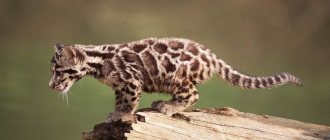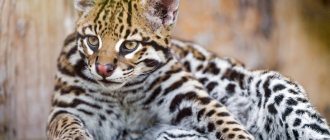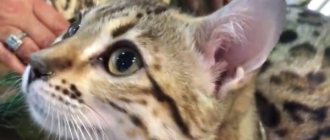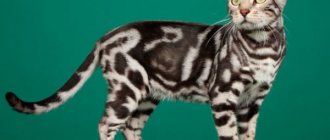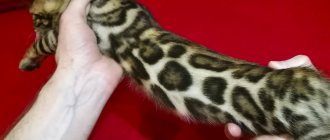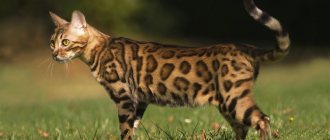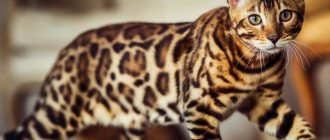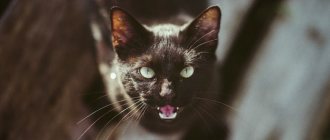Since the moment of official recognition of the Bengal cat breed, these rather exotic pets have attracted well-deserved attention. After all, Bengals are characterized not only by bright external characteristics, but also by the fun and playfulness characteristic of most cats, an open and friendly character and a well-developed intellect. Both adults and children can find a common language with a Bengal cat. Especially if the members of the family in which the Bengal appeared are accustomed to leading a healthy lifestyle and actively spending leisure time and, what is important, are sincerely ready to take care of the new pet and take responsibility for its comfortable stay with the person.
Who is best suited for a Bengal cat and how to make friends with it? What does she look like and how long does she live? What are her dispositions, habits and favorite treats? FAN presents a brief “encyclopedia” of the life of representatives of the Bengal breed.
pixabay.com/
History of the origin of the domestic Bengal cat breed
One of the names of the predecessor of the modern domestic Bengal, the Bengal wild cat, is the leopard cat. Therefore, some suggest that Bengals owe much of their origin to leopards. However, in reality, Bengal cats are no closer to it than other domestic cats, although they belong to a different genus of cats - Oriental. In general, the Bengal cat is an intergeneric hybrid between the wild Bengal and the domestic cat. From their wild ancestors, which, as we have already found out, were not leopards, these animals inherited the characteristic “spotting” and, of course, the very name of the breed - the Bengal domestic cat. Also, from their ancestors, today's cats inherited unusually beautiful shiny fur.
The Bengal cat has gone through a rather long and thorny path to the recognition of breed standards, and it was bred through the efforts and determination of the breeder-felinologist from America Jane Mill . The fact is that the founder of the breed has long been looking closely at the problem of extermination of the already mentioned leopard cats from the wild and decided that breeding domestic cats that retained the same color could attract public attention to this serious problem.
This idea was born in 1961 - during Jane's fateful trip to Bangkok, when she came into her hands with a tiny baby of a local leopard cat, which was almost impossible to tame. The wild kitten settled down with its new owner, and then the grown-up baby reproduced offspring from an ordinary domestic cat, but personal circumstances did not allow Jane to complete the formation of a new breed.
The second and decisive attempt to immortalize the endangered leopard cat in the form of its domestic clone was made by an American in 1980. The “material” for selection was leopard cat hybrids, as well as pets of various “modifications” and the golden-red Indian cat, to which future Bengals owe their shiny coat.
The process took a long time, but Jane’s efforts paid off: in 1987, the new exotic breed was successfully presented at the exhibition, and in 1991 it was officially recognized. Since then, the Bengal cat, along with other representatives of purebred domestic cats, has been admitted to exhibitions and breeding in specialized nurseries.
pixabay.com/
Estimation of breed characteristics
| Adaptability: |
| Shedding level: |
| Social need: |
| Grooming: |
| Ease of care: |
| Attachment to family: |
| Hair loss/shedding: |
| Health/susceptibility to disease: |
The selective breed of Bengal cats, which appeared a little more than half a century ago, has a unique color and special disposition. So far, the small population in the world is in demand and is actively developing. A Bengal cat of any color looks very exotic.
What does a Bengal cat look like: description and breed standards
Just one quick glance at a Bengal is enough to understand that this is a representative of an exotic breed. After all, it is impossible not to notice the external differences between a Bengal cat and a “traditional” cat even at a very tender age - primarily due to its unusual “leopard” color. Needless to say, the grown-up Bengal also receives the most rave reviews. But exotic skin alone is not enough for this handsome man to be recognized as a true representative of the breed. After all, there are certain WCF standards, according to which the Bengal must be endowed with a number of characteristics.
A cat of this breed has a fairly large and muscular body: any photo of a Bengal will demonstrate this perfectly. Its paws are large and powerful, round and springy. At the same time, the hind ones are longer and more developed than the front ones. All this allows the animal to tirelessly rush around the apartment, using a dense, medium-sized tail, also endowed with “leopard” rings or spots, as a steering wheel.
The Bengal's head is placed on a strong and muscular neck, ideally proportional to the body. It is a wedge, topped with a massive chin, and the cat's muzzles are slightly thickened, due to which the muzzle of the bearer of this breed resembles a tiger's mouth. This is especially evident during growling or yawning. The cat's ears are moderately short and set high - round at the tips and wide at the base. The Bengal's nose is large, evenly wide and slightly curved. And, of course, the eyes of the true son of his wild Bengal ancestors are very, very beautiful. They are intelligent and deep, almond-shaped and clear green or golden in color.
The coat of Bengal kitties is soft and short and is practically not subject to shedding. In addition, the breed standard assumes a considerable richness of color - from the most popular spotted-striped with shades of white, red, brown or gray to, in fact, spotted - the coat is golden, and the tip of the tail is black. The merle color variation suggests the presence of “non-leopard” spots. Among this breed there are also so-called “snow leopards” - truly royal cats, painted in white and gray shades. The color palette continues with cats of rosette on gold or silver, seal-mink, charcoal and even blue.
Concluding the topic of the color of Bengal cats, it is necessary to mention such concepts as glitter and phasing. Phasing (from the English word “fuzzy” - “uncertain”) is a common phenomenon, as a result of which Bengal kittens at the age of one to four months suddenly become covered with gray or dull white hairs - so that the animal’s color appears “blurry” . Too much pronounced phasing prevents the consideration of the real color and pattern of the fur coat, but, fortunately, by eight months this effect disappears and the beauty of the fur returns in full.
Glitter is a strongly pronounced shine in a Bengal's coat, which, like phasing, does not appear in all kittens and is not a mandatory feature of the breed.
pixabay.com/
Description
These mini leopards, with their sleekness, flexibility and spotted coloring, are a stark reminder that cats were wild 9,500 years ago.
And this wildness haunts people; they try again and again to create a domestic cat that will resemble a wild one. Judge for yourself: Egyptian Mau, Ocicat, Pixie Bob, Savannah Bengal.
These are developed, large athletes, their bodies are long, but not of the oriental type. Developed muscles (especially in cats) are one of the distinctive features of the breed. The legs are also muscular, of medium length, the hind legs are slightly longer than the front ones.
The neck is long and appears thick, but is in proportion to the body. The head is in the form of a modified wedge, with rounded contours, rather long than wide and looks small in relation to the body.
The eyes are oval-shaped, almost round, large. Eye color can range from gold, green to blue in point cats. The richer and deeper it is, the better.
The ears are small, short, wide at the base and rounded at the tips, set at the edges of the head.
Luxurious coat of medium to short length, close to the body, dense, but surprisingly soft and silky. Bright markings create a contrast with the main color.
What are the dimensions and weight of Bengals?
The Bengal cat has quite impressive dimensions: at the withers, an adult cat of 1.5-2 years is approximately 40-41 cm. At the same time, a cat usually weighs 3.5-5.5 kg, and a cat - 5-8 kg. However, when purchasing a Bengal pet, you need to know that in some cases there are cats of both sexes both larger and smaller than the established values. But even if your Bengal cat suddenly turns out to be “too” large, this does not mean that obesity is to blame. Most likely, such a mass arose as a result of the pet’s well-developed muscles, because due to the characteristics of the breed, Bengals are very active and energetic animals, so they are definitely not in danger of being overweight. As for the length of the cat, it is usually about 90 cm.
Health
Like all cats obtained from wild animals, Bengals are distinguished by enviable health and a life expectancy of up to 20 years.
They do not have the inherited genetic diseases that plague hybrid breeds.
Before purchasing, make sure your cat is F3-F4 generation, as the first generations are too wild cat-like and can be difficult to control.
It is difficult, if not impossible, to meet first-generation cats in our latitudes and you have nothing to worry about.
Features of the character and upbringing of Bengal cats
Mentally weighing the pros and cons of the breed, you should first of all understand that a Bengal kitten is like a child: everything is interesting to this nimble rascal, he strives to get into everything. Forget all your previous ideas about cats lounging all day long on a cozy lounger: the level of activity of your new friend will not allow him to sit still for long. With a high probability, the cat will follow you around the house, wanting to be involved in all the affairs of the family, and in response to being ignored, it will be seriously offended. Therefore, when purchasing a Bengal, plan to entertain him thoroughly.
How to raise this little mischief maker who can jump on you in the middle of the night, chasing imaginary prey? This process should begin as early as possible, because after eight months it will be much more difficult to rid the cat of unwanted habits. In addition, the pet will be nervous, which will certainly affect its life expectancy. Fortunately, Bengals are not only extremely smart, but also, along with other, no less exotic Abyssinian cats, they are quite easy to learn “decent manners” and train.
You will be surprised, but your pet can be taught to walk on its hind legs, roll over on command, fetch slippers, and so on. Not to mention potty training a Bengal. The pet grasps commands without much difficulty, just like the dog. Like a dog, he is ready to defend his personal territory, bring an abandoned toy to his owner, and even protect him from people, objects or household appliances that, in the animal’s opinion, are unfriendly.
Play is an important element in the development and education of a cat. She will help him express his predatory instincts safely for himself and the interior of the house. The main thing is to correctly stop possible aggressive actions of the baby. And, of course, the cat absolutely needs physical activity, without which the animal will wither away.
The Bengal cat has a bright character, in which the natural intelligence of a predator is harmoniously combined with the softness and playfulness of a domestic cat. The Bengal cat is well socialized, attached to the owner, and faithful to him, like a dog. She is sensitive to changes in the mood and atmosphere in the house, and also perfectly remembers words and intonation addressed to her. These cats love the company of people, they are quite talkative, affectionate and friendly, including other pets, including dogs, with whom the Bengal will happily make friends.
However, you should not squeeze this animal too much - the rare Bengal cat will be delighted with this.
“Five minutes of tenderness,” this is how Marina Brakstad the behavior of her pet, a Bengal named Felix.
“He will come, purr, cuddle up to me for five minutes, and then move away, he doesn’t really give into my hands, but at the same time he doesn’t go far, he’s always there,” she said.
Bengal cats also do not favor spontaneous communication with strangers: in order to make friends with house guests and begin to trust them, the animal will need time.
pixabay.com/
Simple feeding rules:
- 80-85% meat (chicken, rabbit, beef, lamb, lamb, etc.)
- 10-15% edible bones (except tubular ones, such as chicken bones, let's give the neck, keel, joints)
- 5-10% tripe (various internal organs)
- cut into small pieces for kittens and larger pieces for adult cats
- always make sure that the meat is fresh, buy only from trusted sellers
- most cats prefer meat warm or at room temperature
- you can also give fish, eggs, kefir, cream and other foods that your cat loves
As for cat food, including dry food, you can feed it only, but such food will be far from what your pet needs.
Give a variety of food and your Bengal will grow big, beautiful and healthy.
What is the best name for a Bengal cat?
Experiment by taking turns calling the Bengal cat that first crossed the threshold of your home with different pre-prepared names, and watch her reaction: there is a chance that she will “choose” a nickname for herself. One way or another, hissing sounds are desirable as part of the name, to which your new animal is likely to react. It is highly desirable that the cat’s name begins with the same letter as its official, “passport” name. And, of course, you should not give a new friend the name of your former pet - this is considered a bad omen, especially if the previous pet disappeared or died of illness.
For charming Bengal girls, nicknames such as Lika, Fanta, Sheba, Astra, Stesha, Dosya, Lynx or even, for example, Skoda are perfect. Stately Bengal boys can proudly bear the name Alex, Onyx, Harley, Simba, Chester, Spotty and, of course, Leo - in honor of the wild bearer of a similar spotted coat.
Have you decided to get this breed?
Then these tips will be useful to you:
- Buy only from a nursery or reputable breeder
- Complete the purchase and documents for the animal
- Check your kitten's eyes, are they clean and clear? Make sure he doesn't have a runny nose
- Kittens should be picked up no earlier than they are 10–12 weeks old.
- There should be no diarrhea or its symptoms. Look under the tail, check that everything is clean and there is no redness
- The coat should be shiny, clean and not look greasy, this could be a sign of illness
- Find out if you have been vaccinated
- The kitten should be active, playful and curious. A little shyness when meeting people is normal. Avoid adopting lethargic kittens
- Take a closer look at other kittens and adult cats, do they look healthy and active?
- Is the room clean?
- Find out if the kittens are litter box and grooming trained?
- Please clarify whether genetic tests have been carried out for the presence of diseases?
Features of caring for a Bengal cat
Since the Bengal kitty is short-haired, it requires less care than its shaggy counterparts. The animal is already accustomed to carefully licking its fur during fairly frequent sessions of “technical self-care.” So the owner can only brush the cat’s fur a couple of times a week using a soft rubber brush. The exception is the molting period, during which you can brush your pet more often.
Your cat's claws need to be trimmed about twice a month. The ears should be cleaned at the same frequency using a slightly moistened cotton pad. But it is recommended to brush your pet’s teeth much more often - once a week. Rare washing of the cat is also allowed. Special cat shampoos are designed for this. It is advisable to provide the Bengal with access to water, because the desire of these cats to frolic in it and fish is inherent in nature itself, so even an ordinary swim in a city bath will give the animal considerable pleasure: they can even take a shower with you.
pixabay.com/
Care and maintenance
The cat took from its ancestors not only beauty, but also independence. Caring for its appearance is very simple.
Moving into a new home
Keeping this breed is a little more difficult than keeping a regular cat. Bengals need an organized territory, where there will be a food, recreation area and, of course, a large play area. Then he will not spoil the furniture and disturb the owners.
Basic set of items:
- A full bowl of clean drinking water and dry food should be freely available.
- Place a tray in a secluded place that matches the size of the cat. Representatives of the breed like to actively bury their surprises, so the layer of filler should be large.
- It is advisable to install a running wheel where cats will expend excess energy.
- A scratching post is a must. Sometimes one set of cat posts is not enough. The animal is allowed to sharpen its claws only in one place, away from upholstered furniture and walls.
- You can equip a sleeping and rest area. If she is not there, the pet will find a place for itself in a chair, on the sofa or in the bed.
Hygiene and medical procedures
Caring for Bengals is simple, although it should still be done regularly:
- It is enough to brush your cat once a week. The fur is short. She does not need daily brushing, because... tangles do not form, and shedding is not as obvious as in long-haired breeds.
- Discharge from the eyes is removed daily using a damp cotton pad. Some animals cope with them on their own.
- Ears are examined every 1-2 weeks. They should be clean and light pink in color. If there is dirt, clean the ears with a damp cotton pad.
- To prevent your pet from tearing up the beautiful interior and upholstered furniture, her claws are trimmed every 2 weeks. Use a special nail clipper. Even if you have a scratching post in your home, you still need to trim its claws.
- It is not necessary to wash the libimitsa; they are very clean. Bathing is carried out no more than once every 3-4 months, or it is carried out with very intense pollution. They use only specialized products for cats. Bengals love water, so washing them will not be a problem.
Diet
The most convenient and simplest feeding option is to purchase ready-made commercial feed. The menu will be balanced, healthy, and the owner will not have to cook.
They buy premium, super-premium, holistic food. Like its wild ancestors, the Bengal cat has a shortened intestinal structure. She has a sensitive digestive system that immediately reacts to low-quality food, chemical additives, and changes in diet. Finding the right food will take some time.
Some owners still prefer natural food:
- 80% of the total diet is meat. It must be dietary. Suitable for turkey, chicken, rabbit, beef. 1-2 times a week you can treat your cat to low-fat varieties of fish. The fillet should be boneless. The meat is deep frozen in advance for at least 3 days. Before serving, it is doused with boiling water. This way the owner gets rid of parasites and bacteria.
- They are not allowed to give milk, but it is useful to treat them with fermented milk products. Kefir and low-fat cottage cheese are an excellent addition to the basic diet.
- Vegetables. To ensure that the cat receives all the necessary vitamins, raw or boiled vegetables are added to the meat.
- Cereals must be included in the daily diet. They are boiled in water in advance.
Important!
Food from the human table negatively affects the health of the pet. You cannot treat them with sweets, highly salty foods, or fatty fried meat. Beans and potatoes are contraindicated.
How and what to feed a Bengal
Feeding the offspring of a leopard cat is carried out in accordance with a special feeding schedule, as well as according to the instructions of specialists. If the nutrition is complete, the baby quickly turns into a strong and healthy cat. It is important that a Bengal's diet contains a sufficient amount of protein - this is especially true for large, active and neutered cats. One way or another, approximately 90% of the menu should consist of meat and fish, as well as offal, dairy products, including cottage cheese, vitamins, minerals and polyunsaturated types of acids. The Bengal kitty will not refuse raw rabbit meat and low-fat cream, as well as vegetables - tomatoes, carrots and so on. But it is better to replace raw offal with boiled sea fish.
Bengal cats are extremely susceptible to poor quality food, which is why your pet should receive only selected food and not stagnant water to avoid loose stools and health problems.
You can also switch your Bengal cat to dry food. True, the “rule of the highest quality” should also work here: it is desirable that the popular crispy “cookies” be not just premium, but super-premium.
Métis
There are significant features in breeding the Bengal cat breed. They currently do not have officially recognized mestizos due to the ban of felinological communities on crossing with other species. There are also few unofficial “derivatives” based on Bengals; sometimes it is difficult to recognize and distinguish them from the real ones. The recently bred cashmere (or silk) Bengal with long hair, which has become more and more loyal to specialists over the years, has shown that there is a “dormant” gene for long hair in the gene pool of the hybrid. A special text is dedicated to the mixed breeds of the Bengal cat.
Health Features of the Bengal Cat Breed
The excellent health indicators of the Bengal are the result of successful breeding work combined with the natural immunity of wild beauties, taken as the basis of this breed. However, there are also certain diseases of a genetic nature, which, fortunately, can be successfully treated or avoided in most cases.
For example, one of the most characteristic phenomena is a dry nose, which is present in Bengal cats under the age of one year. Due to excessive dryness, the baby’s nose sometimes becomes covered with cracks and crusts. This is not dangerous to health, but it is better to consult a veterinarian and have the nasal surface treated so that the existing problem does not develop into an ulcerative lesion of the nose.
A more serious genetic problem is hypertrophic cardiomyopathy, which, however, with proper monitoring, regular testing and good care will allow the cat to live a long, happy life. As well as flat chest syndrome, which poses a more serious threat to survival. Fortunately, the absence of inbreeding and the use of antibiotics by a pregnant cat will reduce the occurrence of reported problems in the offspring to zero.
Bengal cats must be vaccinated on time - in accordance with the established schedule, from the age of eight weeks. Before each vaccination, a veterinary examination of the animal is required. If you want your pet to produce offspring, you will need the help of a specialist, because otherwise, even a successful mating does not guarantee the birth of full-fledged kittens. If you want to sterilize an animal, you must not miss the onset of puberty.
Answering the question of how long Bengal cats live, we can say that their average life expectancy is from 12 to 15 years, however, under the supervision of attentive and caring owners, a Bengal can easily reach its 16th birthday, while remaining in good health.
pixabay.com/
Pregnancy and childbirth
The gestation period for the Bengal cat is normal for the species - about 65 days. They count down the days from the moment of successful mating, which will be indicated by such indirect signs as the cessation of estrus, changes in behavior. An ultrasound confirms the presence of kittens in the uterus after 15 days. Bengal cats usually give birth on their own; assistance may be needed during the first lambing. However, it is recommended to undergo an examination and adhere to the advice of a veterinarian. You can read more about pregnancy and childbirth.
Read more about Bengal pregnancy
How to buy a Bengal kitten and what is its cost
There are many nurseries in Russia where you can purchase a Bengal kitten. However, despite the fairly wide distribution of the breed, it is unlikely that you will be able to save money on it - unless, of course, you want to become the owner of a truly thoroughbred animal.
Before purchasing, you should find out as much information as possible about the future pet: its pedigree, character traits, general interesting facts about the breed, the subtleties of interaction between humans and Bengals. As for the price of a Bengal cat, you should know that this breed is among the top most expensive. In our country, the cost of an animal ranges from 25 thousand to 100 thousand rubles.
This is primarily due to the difficulties with breeding Bengals. The first generation of male kittens remains infertile, while their sisters are crossed with full-fledged representatives of the breed, after which a second generation is obtained, most of the males of which are also infertile. In the third generation, a minority of males already suffer from infertility, but only in the fourth generation are kittens considered full-fledged representatives of the breed. Now you know almost everything about this magnificent spotted kitty: although in order to decide whether it is worth reviving your home with it in the near future.
Kittens
Bengal kittens stay with their mother for at least two and a half to three months. This period allows them to get stronger physically, socialize, and receive a mandatory package of vaccinations. Moving to a new home and separation from relatives inevitably greatly frighten the baby with noise, smells, and movement in the carrier. The owner will need attention and patience: it is not easy for a kitten to make new contacts and get used to unfamiliar housing. The articles “Caring for a kitten”, “Food for Bengal kittens”, “Education, training”, “Colors of kittens and phasing” contain recommendations regarding all processes of communication with little Bengals - funny in their hunting habits.
Interesting facts about Bengals
1. Representatives of the Bengal breed love water - a feature inherited from wild ancestors who still live in Asia, rich in various bodies of water.
2. Initially, the breed was included in the lists of cat associations with the name “safari”, and was rightly renamed in honor of the wild Bengal ancestor, which it resembles.
3. For the first time, Russian admirers of purebred cats saw a French Bengal named Lucia at an exhibition in 1997. Soon, foreign exotic-colored representatives of the breed registered in Moscow felinological clubs.
4. Bengal cats are a “talkative” type of cat. The vocabulary and sound reserve includes not only the usual meowing and purring, but also such unusual sounds as clicks, growls, and trills.
Exhibitions
The first exhibition in the biography of the Bengal cat after the standard was adopted for it in the early 1990s was the TICA championship. Jane Mill with her absolutely tame “leopard” was a resounding success. Following the premiere, the triumphant march of the new breed around the world began. Although there are no separate international exhibitions for Bengals (except for nursery and club shows), they have repeatedly won cat championships. Russian representatives also have success: the Muscovite Oldrace Oscar is included in the TOP-3 best Bengal cats in the world according to the WCF system.
Colors
The breed standard recognizes 3 colors:
- Brown and all its shades. The eyes of such cats are golden.
- Snow or silver. This is a pretty rare color. Kittens are born white, and as they grow older, the fur acquires a snowy hue and a characteristic pattern. Blue eyes.
- Blue. This is the rarest color. The coat color is blue-gray and the chest has a slightly peach tint.
The pattern on wool is divided into 3 types:
- Marble. The spots are symmetrical, with large ones on the back and sides and small ones on the stomach. “Butterfly wings” are drawn on the shoulders.
- Spotted. Oval spots of different sizes.
- Rosette. The sockets are of different sizes and are located asymmetrically.
The charcoal color does not yet have a color code, but it may also be recognized soon.
Cat couples
Anyone who watches two cats play and cuddle will quickly forget the stories of the lonely hunters. Young cats, especially siblings, can usually be socialized without any problems and develop lifelong friendships. Animals of the same breed or other fairly large and active breeds or domestic cats are especially suitable as partners for the active and physically strong Bengal cat. Since the individual personality traits of the animals always determine whether two animals are suitable for each other, there are no basic recommendations, but the interaction of young Bengal cats with gentle, calm animals can lead to problems.
Therefore, it is preferable for couples with similar temperaments to be together. But people can also promote greater harmony between cats by keeping the active cat busy with wild play, while the quieter cat can satisfy her need for lap cuddles. Of course, cats and male cats in multi-cat households should always be neutered.
Advantages and disadvantages of the breed
| Advantages | Flaws |
| Unique appearance. | Most Bengals do not like to be picked up or hugged. |
| Loyalty to the owner and friendliness. | Excessive activity. This breed may not be suitable for calm people. |
| Love for children, and patient attitude towards other pets. | Price. |
| High intelligence and good ability to learn tricks and commands. | The Bengal constantly needs the attention of its owner; it cannot be left alone for a long time. |
Character
The Bengal cat breed differs in character both from its wild ancestors and from its domestic relatives. This is not a pet that can be carried around in your arms. However, Bengal cats are very people-oriented. They are loyal and need constant contact with their owner. This breed is not suitable for people who are constantly at work. Without communication with their owner, Bengals become destructive and aggressive.
Bengal cats treat children well. If the baby accidentally hurts the pet, the Bengal will prefer to simply leave rather than use its claws. Bengals are wary of strangers and do not immediately accept them.
The Bengal cat gets along easily with other pets. The main thing is to properly socialize the Bengal. But small rodents and birds can easily become prey for a domestic leopard, since this breed has a very strong hunting instinct.
Usually a Bengal kitten quickly gets used to its new home. He constantly follows his owner and demands attention with his voice. Some individuals need time to adapt. If the baby does not immediately make contact, do not touch him. You need to let the kitten get used to the new place. Despite prejudices, this breed practically does not show aggression. It is important to approach raising a kitten wisely.
You cannot use force against a Bengal, otherwise he will stop trusting his owner and will begin to treat people with hostility.
Bengals have high intelligence. They can be taught to perform tricks. A cat should be trained only when it is in the mood for training with its owner. It is better to choose tricks that the pet itself shows a penchant for. For example, some cats can be trained to fetch a toy for their owner or jump over obstacles.
Bengal cats are cunning. They can deliberately play some pranks just to attract the attention of the owner. For example, dropping items from shelves.
Bengals are very active. They can play and jump around the house all day long. A special playing complex should be equipped for the cat. In addition, it is advisable to attach shelves under the ceiling. Bengals have inherited some of the habits of their wild ancestors, and therefore they like to watch everything that happens from above. A cat should have many different toys.
Groups of cats
There are some benefits to owning multiple cats, but it is a lot of work and requires experience with cats. A completely different dynamic can develop within a group, and friendships and alliances can develop. Doesn't your friend feel like playing right now? There are other cats, one of which is definitely looking for action. Animals rest more comfortably when their playmate can shy away, and shy cats can calmly observe the behavior of other animals.
A group of cats that are good with each other is just fun, and people always have a cat that just wants to play or cuddle. This, of course, can also be a disadvantage because there is almost ALWAYS a cat that wants to play or snuggle. And each cat in the group needs time with its own person, even though it has several companions. A rule of thumb you'll often hear is that you shouldn't keep more animals than you have hands to pet. With two people it would be 4 cats or, for example, 3 cats and 1 dog. This rule offers initial orientation, but must always be assessed on a very individual basis. A couple in which both partners work full-time can usually encounter fewer cats than a retired couple, despite having the same number of hands.
Diet
Typically, wild Bengal cats feed on small game, such as mice, rats, hamsters, rabbits, squirrels or birds.
During periods of hunger, the animal can hunt various reptiles, insects, and small animals. Sometimes they can fish, but most often they hunt on land, since their color helps them in such conditions.
If a wild animal finds the eggs of other animals, then it will eat them too.
For domesticated wild Bengal cats, you need to choose a special diet. It must be balanced and contain all the necessary vitamins, minerals, and macroelements.
The animal can be fed with special balanced feed. But it is very important not to focus on them, but to give them more meat and other natural foods.
Industrial feed
The digestion of Bengals is quite difficult to tolerate a change in diet. Buy good, expensive industrial food. It is completely unreasonable to buy a pet for a lot of money and then spoil its health with bad food.
The food must be of the highest quality. It is best to ask the breeder what food you can feed your little leopard. It is important that a cat on such a diet always has fresh water. It is best to buy electric bowls in which the water is constantly renewed. This will resemble a pond or stream and will inspire more confidence.
Natural food
But it is best to feed the animal with natural food. Many people believe that if you feed a predator meat, it will become even more wild. This is wrong. Such an animal really needs raw meat, since only through it can the cat receive the necessary elements.
The meat can be anything: chicken, beef, fish. You can add porridge (without milk) and boiled vegetables to your diet.
Wild bengal in an aviary
History of the discovery of the species
The wild Bengal cat is a small predator that lives in the territories of East and South Asia.
But she can only be found there. Its distribution area is wide. This predator is a direct relative of the Asian leopard. Everywhere it is called the Asian leopard. But in Russian sources it is often referred to as a Bengal and is often confused with a domesticated breed. Bengals that still live in the wild are in danger. Every year they are killed by local residents because of their beautiful, soft fur coat. Therefore, this animal is listed in the International Red Book.
Wild bengal in habitat
